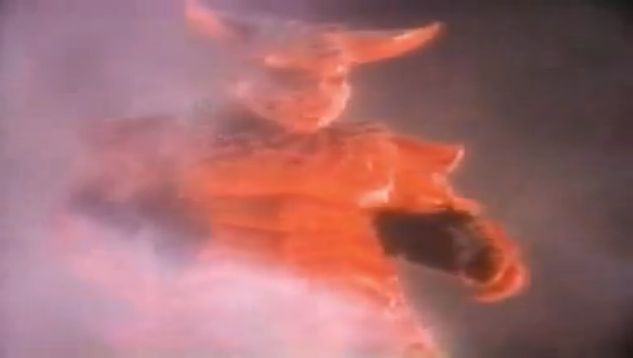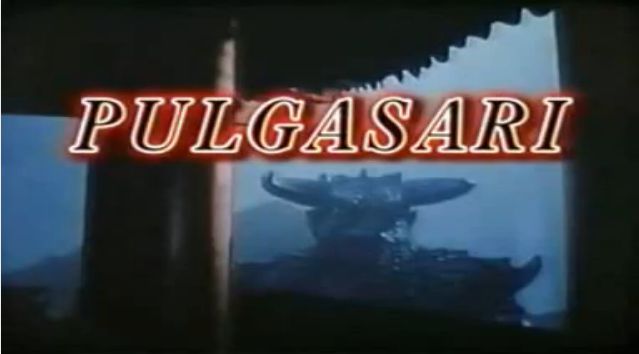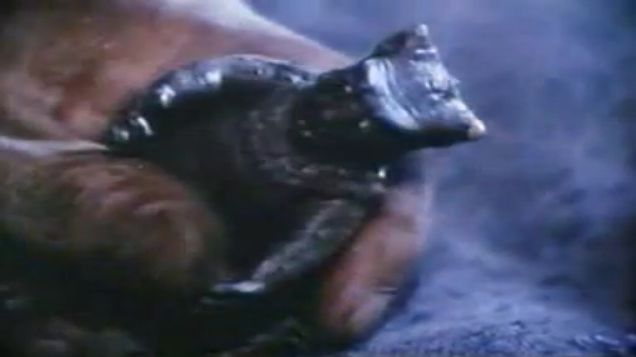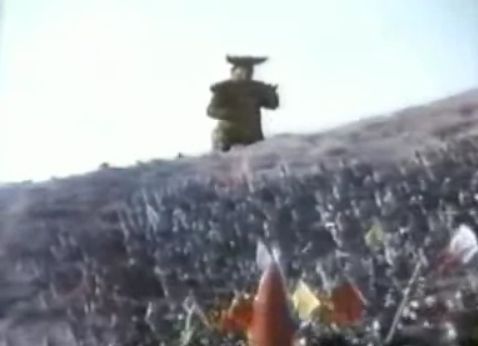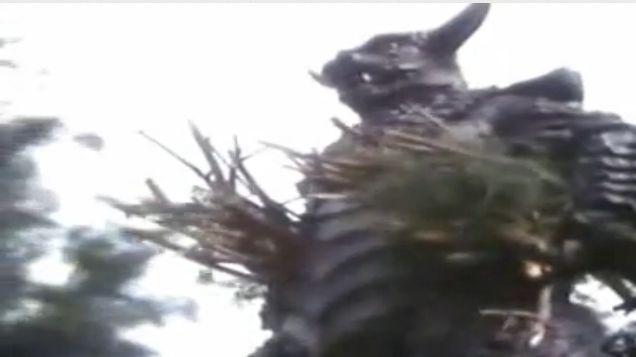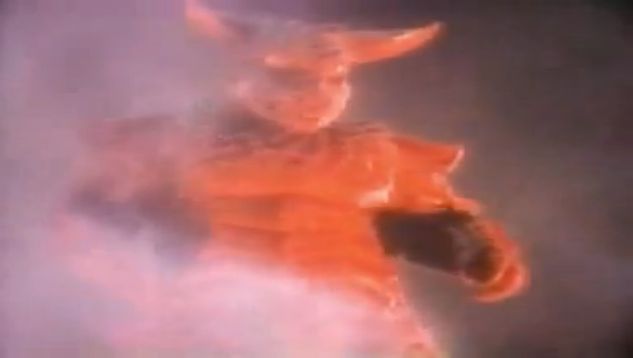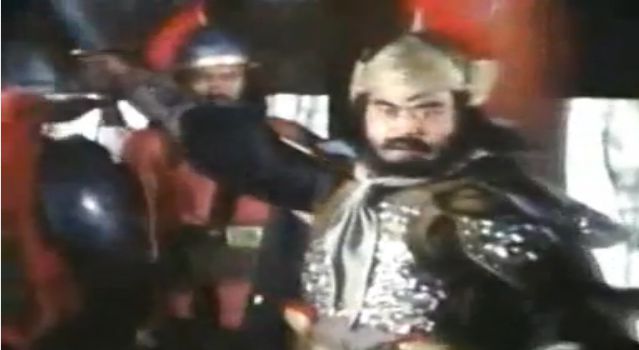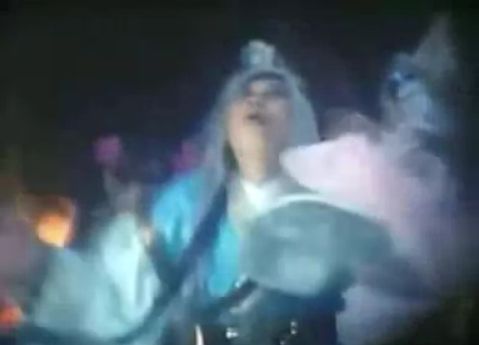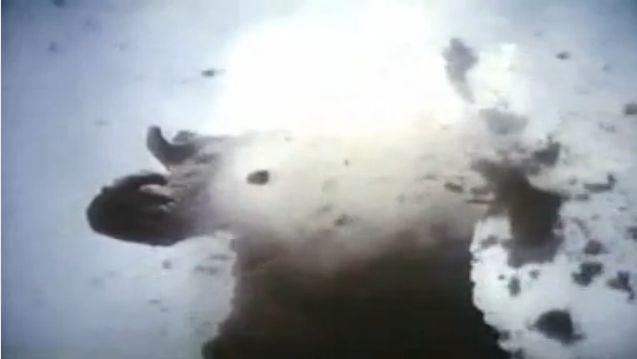Pulgasari has something in common with Kool Aid-Man; at one point he bypasses a door and busts through a brick wall for no discernible reason. What’s Korean for “OH YEAH”?
North Korea is back in the news – the details are too complicated to go into on a site known best for sending mash notes to the hosts of late-night infomercials (“FlavorWave Kathy, in my house you heat up a lot more than mini corn dogs”) but they involve regional geopolitical dynamics, internal strife following the death of Kim Jong Il and a demand to hand over the recipe for Taco Bell “chalupas” to avert future tensions with the South.
Ok, one of those items isn’t exactly true, but I offer it up because I couldn’t think of a third thing that I know about North Korea. I could ask North Korea experts in the West, but they readily admit there’s plenty they don’t know about North Korea – and they’re experts. I’ll give you an example: I read not long ago that North Korea had formally ended its 100 day mourning period for the departed Dear Leader, Kim Jong Il. As the Miami Herald reports, the grand finale came when Kim’s son and the country’s new boss, Kim Jong Un, “visited the mausoleum at Kumsusan Palace of the Sun in Pyongyang to observe three minutes’ silence.” The fact that Kim Jong Un led the three minutes’ silence is, by my count, one of only six or so things the West knows about Kim Jong Un. We know his name, we know his nickname (“The Great Successor” in North Korea; abroad he’s inexplicably known as “Big Marty”) and we know he is not the inventor of bologna casserole, but that’s about it. We don’t even know the guy’s age for sure – the Herald says he’s “believed to be under 30,” and don’t expect to find out anytime soon. It’s not like Pyongyang Liquor Warehouse is gonna card the guy.
Yes, what we don’t know about Kim Jong Un could fill a warehouse (but not Pyongyang Liquor Warehouse, I made that up), though there are plenty of people at Langley and Vauxhall Cross and Omaha Finer Foods and North Korea Intelligence looking to find out as much as they can. To them, I ask, while you’re gathering knowledge on the country and its leadership, could you find out one thing for me? I’d like to know if Kim Jong Un has made, or is planning to make, any monster movies.
I ask this because that’s what his dad did in the 80’s. Kim Jong Il was not the only totalitarian leader to make a film, but I’m pretty sure he was the only one to make a kaiju film directed by a South Korean filmmaker kidnapped by Kim Jong Il for this purpose. The result is “Pulgasari,” an elaborate Godzilla-visits-ancient-Chongjin that is more puzzling than truly bad. Put another way: travel companies who run North Korea tours describe their trips by saying, as destinations go, North Korea is not the most thrilling place, nor the most scenic, and not the most exciting, but it’s truly unlike any other place you’ll ever visit. Think of “Pulgasari” in that spirit. It is by no means a great b-movie, but its awkward attempts at blockbuster-ness give it a puzzling sort of charm. So let’s dig deeper into this unique filmic moment, the one instance in which the words “produced by Kim Jong Il” weren’t followed by international sanctions:
The movie takes place in feudal Korea, where a corrupt and selfish king exploits a village made of friendly and extremely put-upon farmers. The friendliest and most put-upon of these families does some metalworking on the side; there’s a nervous mother, a wise, bearded father, a plucky daughter Ami and a nondescript brother floating around somewhere. There’s also a square-jawed fellow called Inde; I think he’s their nephew, maybe? He leads a smuggling operation to bring in some extra cash, as long as “smuggling” means “wearing a big Rambo headband and wandering around in the mountains” and “bringing in some extra cash” means “bringing in no extra cash.” Another one of Inde’s talents: getting captured by the government. The film misses a chance to be completely meta by having the governor force Inde to make a monster movie while in captivity.
It’s Fusilli Pulgasari!
No, the governor visits Inde’s uncle, the wise old blacksmith, and tells him to take all the villagers’ farm tools and melt them down for the military. The cagey blacksmith gives the tools back to the people and plays coy about where they went, saying “Pulgasari” must have taken them. This is enough to land him in prison too, and the governor orders that he not be fed until he admits that there is no such thing as Pulgasari and fesses up about the missing tools. This is bad in that the old fella hasn’t eaten in a while as it is; daughter Ami smuggles some rice to his cell, but the blacksmith has either gone all-out for revenge or gone completely bonkers from hunger and mixes the rice with some mud to make an action figure, a little dinosaur-looking thing, and asks it to save humanity while there’s still time. Inde and the other prisoners are understandably teary-eyed, though they probably also wondered why they ever thought the crazy old dude was wise in any sense of the word.
At first the cute little dino-buddy saves no one from anything; Ami inherits her dad’s action figure and puts it on a shelf, only bringing him out to ride around with Ponch and John on the “Chips” highway playset. But one day Ami’s mending a shirt, and she accidentally pricks her finger with a sewing needle, and a (very large) drop of blood happens to fall right on the figure, and with a (very small) flash of red light, he comes to life. Pulgasari, I mean, not Ponch – though I would mortgage my house if necessary to get tickets to any movie where Erik Estrada fought North Korean soldiers.
Pulgasari, by the way, is not exactly a world-beater at this point – he’s three inches tall and he’s played by a guy in a rubber costume, prancing around to silly synth music. He follows this stirring display of power by eating Ami’s sewing needles – hey, uh, Father’s dying wish was “help my people,” not “eat the only metal tools my destitute farming family has left”! He does start down the road to badassery after about twelve hours of eating metal, though we can’t be completely sure without a training montage. “This must be the Pulgasari that Father was talking about!” Ami says.
The Pulgasari that Father was talking about trots to town to find a super-size metal value meal, but he finds a government henchman about to lop off Inde’s head, so our little buddy chomps down on the guy’s sword just before the killing blow. That’s helpful for Inde, but not for me – it leads to more wacky/painful synth music and I realize this creature has more in common with Barney the dinosaur than Godzilla. Pulgasari also has something in common with Kool Aid-Man; at one point he bypasses a door and busts through a brick wall for no discernible reason. What’s Korean for “OH YEAH”?
Uh, Pulgasari, the battle is actually several miles further this way.
The farmers love the ever-growing Pulgasari, who helps them win battles (or, perhaps more accurately, wins the battles for them). And each time Master P beats back more soldiers, he eats all their captured weapons and grows bigger and stronger, which leads to more victories. Nice circle. The governor is resolute, even after hearing one of the best lines in movie history, “a beast has appeared and is eating the weapons,” but Pulgasari is so big and fearsome the troops run away and Inde finishes the governor off, very Inigo Montoya-style.
Any minute now Pulgasari’s gonna bust out his rendition of Jethro Tull’s “Songs From the Wood”
The king realizes he needs to get out in front of “the Pulgasari issue” if he’s going to put down the farmer rebellion, and he sends for a General Fuan, who advisers describe as “competent.” Somehow he knows the beast was born of rice and blood, so Fuan plans to pit Uncle Ben and the Red Cross against each other in a custody hearing. Actually, his men sneak out to a party the villagers are throwing – and before I describe their diabolical plan, I want to point out that the farmers have Pulgasari, a giant, invulnerable creature conjured by ancient magic, gathering wood for the fires. It’s a monster movie, and they’ve got the lead character doing chores. Next they’ll have the big guy do their taxes, I suppose. “You are our great ally, Pulgasari! What about my child tax credit?”
Visual effects by Arthur Brown.
Anyway, the competent General Fuan has his men sneak up on sister Ami and take her prisoner, and he orders Pulgasari to get into a custom-built cage or he’ll cut off Ami’s head. Ami says don’t do it, but he goes in. The soldiers then set fire to the cage. Pulgasari is overcome by the flames. Ami cries. The soldiers jeer. The fire burns so hot it engulfs the cage, which EXPLODES and then a newly-red Pulgasari walks out feeling refreshed in the way one feels after a good trip to the sauna. The soldiers flip out and run to their lifeboats, but Pulgasari dives into the water, knocking them out of the boats and (I think) boiling them alive. There is no wacky synth music playing by this point.
It’s an old-fashioned hole diggin’! By gar, it’s been awhile!
Fuan’s Plan B is to dig a big hole in the ground. “Big enough for a huge monster,” he says. “And from here we’ll throw rocks.” Rocks. Fuan knows this plan is crap, but “if we turn back, then we’ll be punished. This will be the final battle.” He draws his sword and issues his dramatic call to arms, “Expedite the digging!”
And I saw Pulgasari in the snow-covered hills til the landslide brought me down…
Ok, technically the hole is really just one part of Fuan’s plan – he hires a priestess to do an exorcism, figuring that if he can cast Father’s raging spirit out of the monster he’ll be easier to control. The exorcist lady has a Stevie Nicks-meets-Korean Swiss Miss kind of vibe. “After a lifetime of hardships, you should rest in peace,” she tells the blacksmith-turned-beast. Then she sings a chorus of “Stand Back,” the big guy stumbles in the gigantic hole and the soldiers bury him under a bazillion boulders. The tide of battle turns; the farmers aren’t so tough without a monster in their corner and they’re routed into oblivion, Inde is captured and put to death, and the village women are forced to serve as concubines.
For like forty seconds, anyway – Ami sneaks around the party, finds the burial pit and drops a little more blood in to revive the creature before any of the drunk-ass troops catch on. Special effects go off, the soldiers run and it’s clobbering time. The farmers launch an attack on the capital, even though there weren’t any farmers left after the previous “final battle.” Maybe these farmers are perennials and grow back after a season. The king has one last trick up his sleeve – a “worker of good repute” building “the greatest weapon in all history.” It’s a double-barrelled cannon – a lion shaped piece called “Lion Gun” and a statue of a guy, called “General Gun.” The king ignores the weak branding and smells victory – “With this,” he says, “even if there were 104 Pulgasaris, it’d be all right.” (104?)
Pulgasari is made of blood and rice and is therefore invulnerable – unless you also add Pop Rocks.
The ultimate weapon that can stop 104 Pulgasaris is, in truth, unable to do much more than give a single Pulgasari a small dose of indigestion; the big guy swallows their missiles whole, belches smoke, spits them back at the king’s palace and that’s when the soldiers realize there’s a regicide goin’ on. Pulgasari calls for a new constitution and parliamentary elections as soon as possible. Then, “for the sake of the farmers,” he turns back to clay and disintegrates, sending his spirit back into Ami in case they ever need to film a sequel.
And that’s all, which is fine with me. As b-movies go this actually wasn’t terrible – you could follow the plot, the acting was competent and production values were decent – there sure are a lot of extras in this movie, which I guess is one thing you can always get as a North Korean film director. That said, it was ponderous and predictable even by monster movie standards. Mildly recommended, mostly for Pulgasari’s iron-munching moxie – reunification or not, the kid’s got a future!

